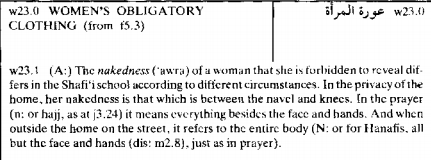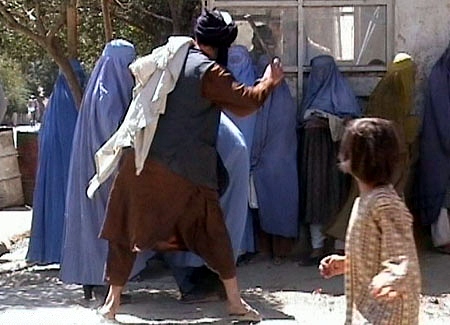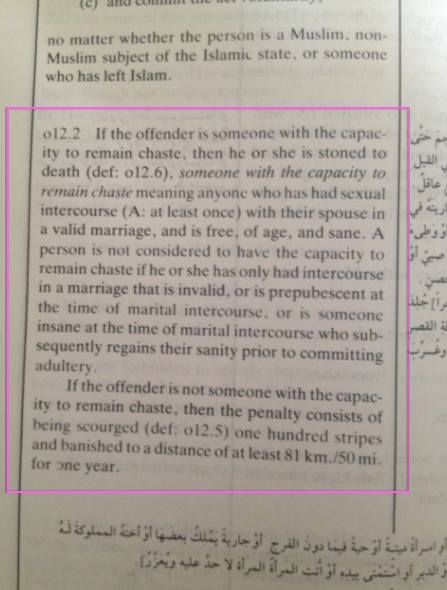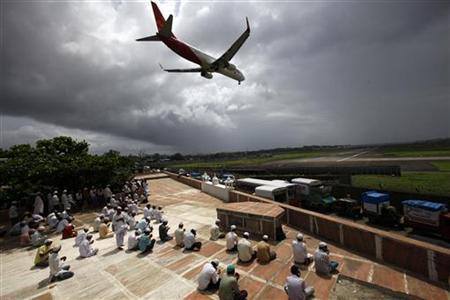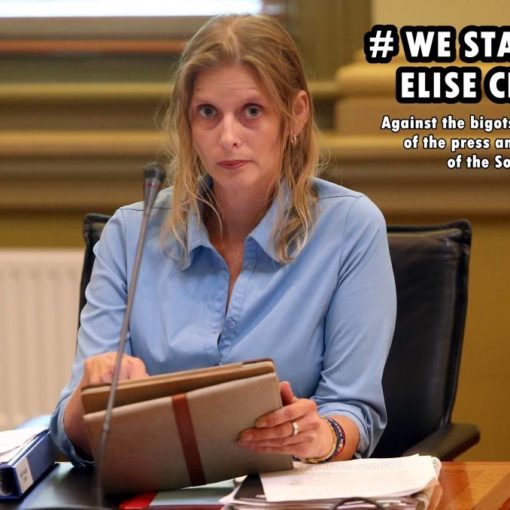In the West we regard some of the head coverings of Muslim women as a form of Islamic oppression of women.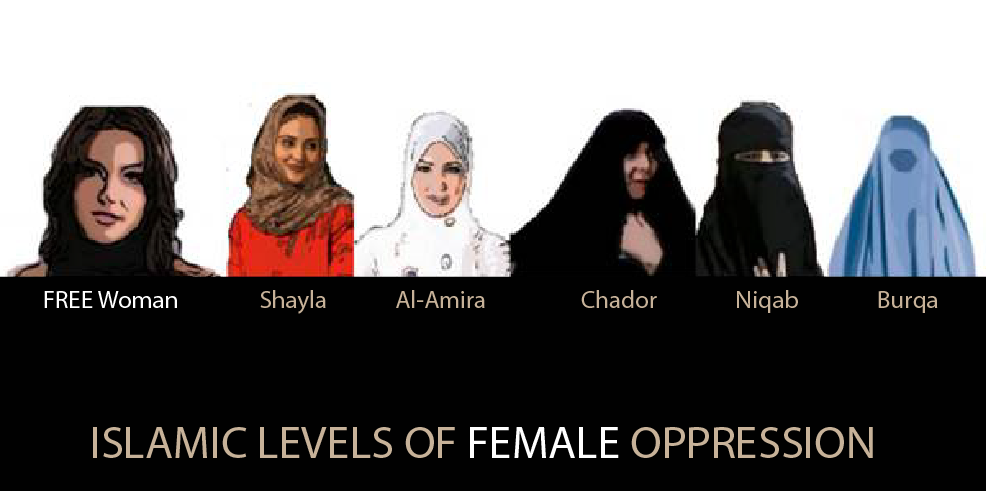
A hijab is a covering that creates a separation or partition for the woman from the outside world. The Word hijab can be translated as head covering, veil or screen.
Despite the protests of many Muslim women that it is their choice to wear a head covering, the truth of the matter is that according to Sharia Law—the Sacred Path of Islam, the wearing of head coverings for women is now regarded as “Obligatory” in most of the Muslim world.
This is an extract from the Relliance of the Traveller—the sharia Law manual for Sunni Muslims—they represent 80% of the global Muslim population. Many families do own their own copy and pdfs are available on online as a ready reference.
Chapter “w” Section 23 clearly states that the hijab is obligatory. “A woman must not reveal anything except her hands and her face when outside the home and on the street.”
What we have noticed is the more fundamental the sect of Islam, the more oppressive this garment becomes for women.
The severe Salafist doctrine in Afghanistan demands women wear the burqa, a head to toe covering where visability is only through a mesh panel in the garment in front of the eyes.
Wahhabism in the Saudi Arabia has women wearing the black niqab, however only the eyes are visible and women often are required to also wear gloves.
Chador is the dress of Iran (Shia) and increasingly Pakistan which exposes the face.
The Al Amira often worn as a starter Hijab, is widely used like the shayla style hijab that we in the west recognise as the most common form of hijab (scarf over a headband).
The Hijab is a Muslim woman’s guard against rape
A female must wear a Hijib because to Muslim men her entire body is a “SEX ORGAN”
This means if any part of her body is exposed, then it is her fault if she is raped.
Hijabs in the nation of Islam are to be worn from the age of 11. However recent calls from Saudi clerics are now suggesting hijabs should be worn by girls over two years of age also, in order to safeguard the child from being raped.
ISLAMIC SCRIPTURE: Al Hadis, Vol. 2, p. 692) Ibn Ma`sud reported from the Messenger of Allah who said:
“A woman is like a private part (sex organ). When she goes out (walking) the devil casts a glance at her (in lust)”
- Women’s beauty is so enticing that men are unable to control themselves if they see an uncovered female although women do not have to cover themselves in front of those males to whom they are related.
- The current perception in Islamic society is that an unveiled woman is asking to be sexually harassed or assaulted. Although not a guarantee, they believe that the wearing of a veil is added protection against the chance of assault.
Take to its extreme we had this shocking report—Filed by the BBC
“Saudi Arabia’s religious police stopped schoolgirls from leaving a BLAZING building because they were not wearing correct Islamic dress, according to Saudi newspapers. About 800 girls were inside the school in the holy city of Mecca when the tragedy occurred
One witness said he saw three policemen “beating young girls to prevent them from leaving the school because they were not wearing abhaya and veil. A large number of girls were burnt alive while their relatives watched helplessly from outside.”
Hijabs as a statement of religious belonging
Unlike Christians who can carry symbols like a cross, Buddhists or Hindus with their displays of beads, tankhas and statues, Muslims have no other way to outwardly show their faith except through dress and flags. All icons, art and artifacts about Muhammad or Islam is forbidden to them. Dress, and scriptural texts have come to represent the only public statement Muslims can make to others about their faith. Hence why we only see hijabs and flags associated with Islam.
From this context some women in the West do don on a hijab or burqa to declare their separation from Western society. However in other parts of the world Muslim women have no choice—as we witness in this picture of a member of the Taliban’s religious police beating an Afghan woman in Kabul on August 26, 2001 for not having her burqa on in public.
Also the the covering is not required to be worn inside the house unless a strange male would come inside the house. However this young woman is being punished for being inside and uncovered in her niqab.
As far as Koranic verses for the veiling of women. There is this hadith concerned Muhammad’s wives. Sahih Muslim 26:5397
‘A’isha reported that the wives of Allah’s Messenger (may peace be upon him) used to go out in the cover of night when they went to open fields (in the outskirts of Medina) for easing themselves. ‘Umar b Khattab used to say: Allah’s Messenger, ask your ladies to observe veil, but Allah’s Messenger (may peace be upon him) did not do that.
So there went out Sauda, daughter of Zarn’a, the wife of Allah’s Messenger (may peace be upon him), during one of the nights when it was dark. She was a tall statured lady. ‘Umar called her saying: Sauda, we recognise you. (He did this with the hope that the verses pertaining to veil would be revealed.) ‘A’isha said: Allah, the Exalted and Glorious, then revealed the verses pertaining to veil.
In short, the sequence of events as laid out in the ahadith are as follows:
- Umar repeatedly asks Muhammad that Allah should reveal verses for the Qur’an pertaining to the veiling of women.
- No such revelation is sent down.
- Umar follows Muhammad’s wives one night when they go out to relieve themselves (go to the toilet) and calls out to Muhammad’s wife Sauda.
- Sauda goes home in a state of embarrassment and relates to Muhammad what has happened.
- Allah then reveals the hijab verse as Umar had wanted all along.
This translated into this verse in the Koran:
Surah 33:59
“O Prophet! Tell your wives and your daughters and the women of the believers to draw their cloaks (veils) all over their bodies (ie screen themselves completely except the eyes or one eye to see the way). That will be better, that they should be known (as free and respectable women) so as not to be annoyed. And Allah is ever Oft Forgiving. Most Merciful.”
This has translated over the centuries into the Sharia law that if a woman is raped and she cannot produce the testimony of four men to vouch for the fact she was raped—she is considered to have committed “adultery”.
(No court will accept the testimony of any number of females against a male in the case of rape.)
The punishment for adultery is 100 lashes if the female is unmarried, or stoning to death if married.
When an unmarried girl is raped, even if it is proven she was raped, the family’s honour in being compromised by the event could lead to the family then killing the girl to preserve that “honour”—even in war times.
Recently the BBC filed this report of Lybian captives that had been raped as prisoners, released, and who now face becoming the victims of honour killings by their family because they were pregnant.
Indeed the oppression of women in Islam is tragic. HIJABS and the veil keep Muslim men UNACCOUNTABLE to our system of democracy, to Western men’s values,our legal system and our Australian way of life…. HIJABS are SHARIAH LAW just don’t belong in Australia.
Perhaps we should encourage Muslim women in Australia to leave off their hijab and experience what it is like to walk around in safety in our community for a day, instead of the other way round, asking us to experience what it like to be separated and oppressed in their archaic Islamic world.
Top recommendations
- Casino Utan Spelpaus
- Casino Non Aams
- Crypto Casino
- Casino Sites Not On Gamstop
- Migliori Casino Online Non Aams
- UK Casino Not On Gamstop
- Gambling Sites Not On Gamstop
- Slots Not On Gamstop
- Non Gamstop Casino Sites UK
- Sites Not On Gamstop
- Online Casinos
- Not On Gamstop Casinos
- Non Gamstop Casinos UK
- オンラインカジノランキング
- Gambling Sites Not On Gamstop
- Casino Online Non Aams
- UK Online Casinos Not On Gamstop
- Melhores Cassinos Online 2025
- Non Gamstop Casinos UK
- Gambling Sites Not On Gamstop
- Online Casino
- Casino Not On Gamstop
- Non Gamstop Casino Sites UK
- Best Non Gamstop Casino
- Crypto Casino
- Tous Les Sites De Paris Sportifs Belgique
- Meilleur Site Casino En Ligne Belgique
- Casino Online Non Aams
- Casino En Ligne Fiable
- Casino En Ligne France
